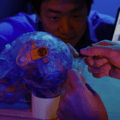Researchers have developed a potentially revolutionary superlens technique that once seemed impossible to see things four times smaller than even the most modern microscopes have seen before. Known as the ‘diffraction limit’ because the diffraction of light waves at the tiniest levels has prevented microscopes from seeing things smaller than those waves, this barrier once seemed unbreakable.
Many have tried to peer below this optical barrier using a technique that researchers in the field term ‘superlensing,” including making customized lenses out of novel materials. But all have gathered too much light. Now, a team of physicists from the University of Sydney says they have discovered a viable path that peeks beyond the diffraction limit by a factor of four times, allowing researchers to see things smaller than ever seen before. And the way they did, it is like nothing anyone else has tried.
Breaking the Diffraction Limit by ‘Superlensing’ without a Superlens
“We have now developed a practical way to implement superlensing without a super lens,” said Dr. Alessandro Tuniz from the School of Physics and University of Sydney Nano Institute and the study’s lead author, in a press release announcing the achievement.
To accomplish this feat, the researchers placed their light probe a distance from the sample they wanted to image and collected high-resolution and low-resolution information. According to the release, the probe gathered light “at terahertz frequency at millimetre wavelength, in the region of the spectrum between visible and microwave.”
Next, that information is entered into a computer and run through processes that effectively “select” the most valuable light and remove the unwanted light. The result is an image that peers through the seemingly unbreakable diffraction limit by a factor of four times, something previous efforts have failed to get past.
“We overcome this (diffraction limit) by performing the superlens operation as a post-processing step on a computer, after the measurement itself,” Tuniz explained. “This produces a ‘truthful’ image of the object through the selective amplification of evanescent, or vanishing, light waves.”
The researchers note that previous attempts to select the high-resolution information at a significantly closer range have been unsuccessful because the most valuable data “decays exponentially with distance,” ultimately becoming so overwhelmed by low-resolution data that isn’t as quick to decay that the resulting image is useless.
Professor Boris Kuhlmey, a co-author of the paper, explains that the key was moving the probe farther away and essentially doing the superlensing in the computer. “By moving our probe further away, we can maintain the integrity of the high-resolution information and use a post-observation technique to filter out the low-resolution data.”
Technique Could Spot Hidden Art, Art Forgeries, and Much More
Published in the journal Nature, the research outlines several possible applications of the ability to see things even smaller than previously thought possible, ranging from medicine and diagnostics to even more previously unthinkable achievements.
“Our method could be applied to determine moisture content in leaves with greater resolution or be useful in advanced microfabrication techniques, such as non-destructive assessment of microchip integrity,” he says. “And the method could even be used to reveal hidden layers in artwork, perhaps proving useful in uncovering art forgery or hidden works.”
Ultimately, the physicists say they have found a way to break through a seemingly impossible barrier using a method dramatically different from previous attempts and hope that their work can help researchers and scientists across a wide range of disciplines.
“This technique is a first step in allowing high-resolution images while staying at a safe distance from the object without distorting what you see,” said Tuniz, who noted that their technique could be used at other frequency ranges as well. “We expect anyone performing high-resolution optical microscopy will find this technique of interest.”
Christopher Plain is a Science Fiction and Fantasy novelist and Head Science Writer at The Debrief. Follow and connect with him on X, learn about his books at plainfiction.com, or email him directly at christopher@thedebrief.org.

